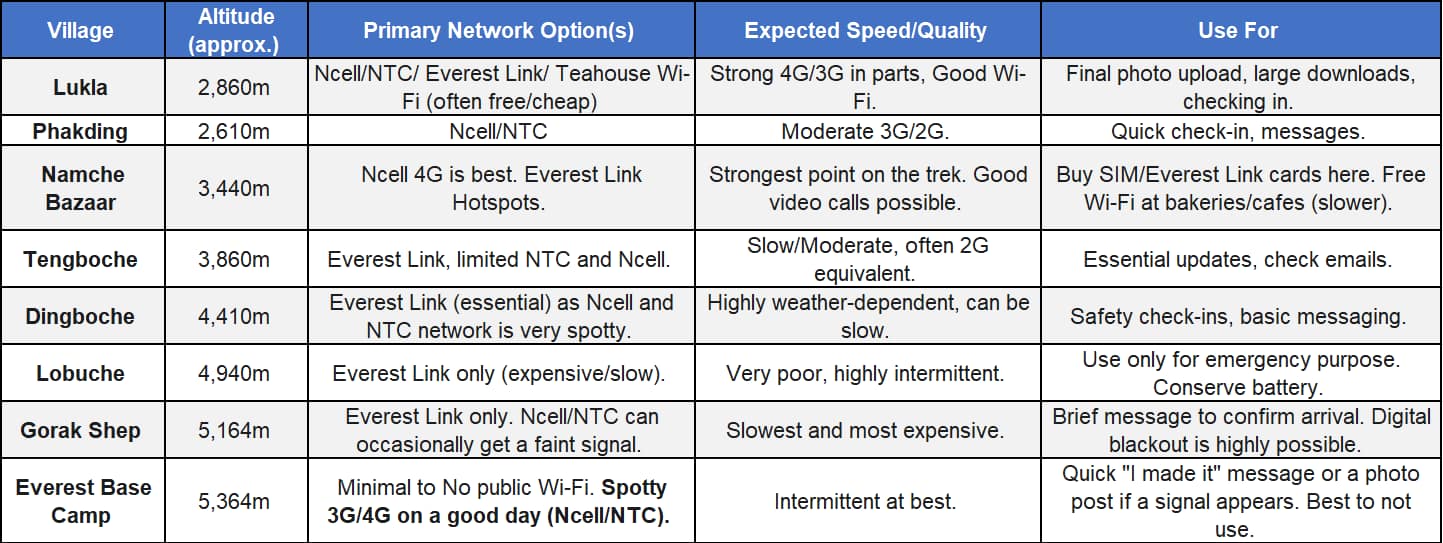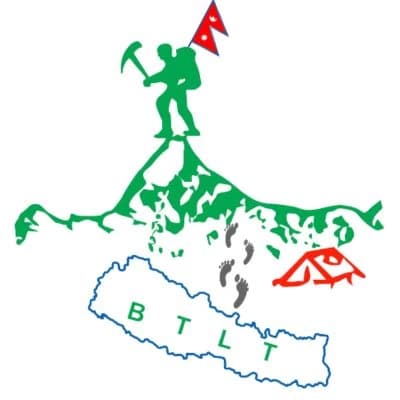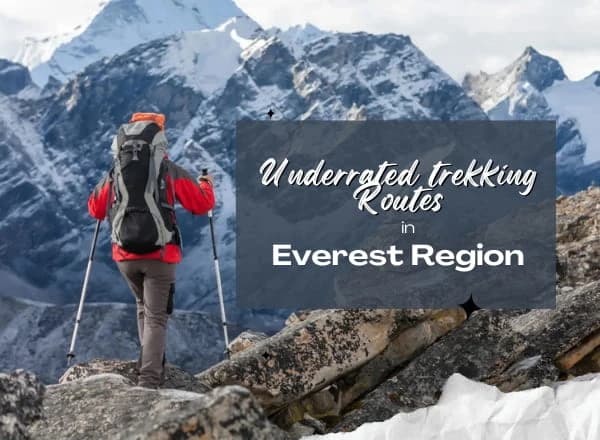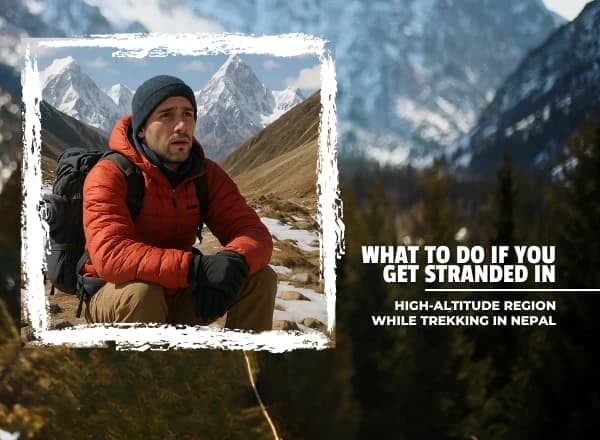The Evolution of Connectivity in the Everest Region:
First off, let’s understand how the connectivity has evolved in the Everest Region over the years. There was a time not too long ago when going for a trek in the Everest region meant being completely cut off with the outer world.
The only messages you could receive were from the winds and the fluttering prayer flags of the region. Whatever communication existed, it was limited to radio sets or satellite phones which were only used by mountaineers and rescue teams.
Today, the story is totally different. While satellite phones have become accessible for a wider range of trekkers, other network and communication options have also entered the region. This includes 3G and even 4G connections provided by the local network providers like Ncell and NTC, as well as Wi-fi connection available in teahouses all the way up to the Everest Base Camp which we will be discussing in detail.
The journey of connectivity represents a trek itself which has gone through many challenges and is now reaching new heights. Now, the trek has become easier due to usage of mobile apps for logistics, and trekkers can share their adventure in real time from one of the most remote corners of the planet.
The Three Pillars of Everest Connectivity:

As mentioned above, the network and connectivity in the Everest region is mainly controlled by three pillars: mobile network, Wi-fi, and satellite communication devices.
Mobile Network:
Mobile network is the most easy and lightweight option for connectivity that is available on the trails of the Everest region. However, it is not very reliable, and the range is limited to certain parts of the trek.
There are two main service providers who give connectivity in the Everest region: Ncell and NTC (Nepal Telecom). You can buy either or even both SIM cards from Kathmandu and Lukla. Keeping both SIM cards is better as you can rely on one if the other one fails.
Ncell offers comparatively stronger data connectivity up to Tengboche and Dingboche. Meanwhile, NTC offers reliable connection in lower sections and works fine in some high altitude areas like Gorakshep too.
From Lukla to Namche Bazaar, the signal is quite strong, and you won’t have any problems connecting to network. The speed range switches between 3G and 4G. However, as you go beyond Namche Bazaar, the mobile signal starts thinning out along with the air. The connection drops to 2G, which means you will still be able to communicate but won’t be able to share photos and videos.
At high areas like Gorakshep and Everest Base Camp, your mobile network mostly won’t work at all as these areas are considered as the digital death zone during the trek. The coverage breakdown is as given below:

Wi-fi Availability on the Everest Trail:
Now that you know that the mobile networks can be patchy during the trek, don’t be worries as where mobile networks fail, Wi-fi saves the day. And this is all thanks to the Everest Link project as well as the Wi-fi available in teahouses.
The Everest Link is a dedicated satellite system that bypasses the need for traditional cell towers and provides connectivity through wireless networks in remote areas. Think of it like the fixed rope infrastructure of the internet in the Khumbu.
To connect with Everest Link, you need to buy an Everest Link card in Namche Bazaar or Dingboche. This card offers prepaid data access usable at multiple lodges along the route. Once you activate the card, you can use it in any village as long as the network signal remains clear. Use it patiently and don’t put much load on the card or else it won’t work as efficiently.
The cost of the card increases along with the altitude. The standard price is 10 to 15 USD for 1 GB and gives a bandwidth enough for messaging and social media. Besides this, many teahouses in the Everest region also have their own Wi-fi services which is powered by solar or other renewable energy sources. You need to pay for this and the cost increases as the altitude increases as well.
The speed of the teahouse Wi-fi is limited and the connectivity often fluctuates as many people are trying to connect to the same network. Weather also affects the connectivity. Thus, teahouse Wi-fi is rarely reliable.
Satellite and Emergency Communication Options:
When every other communication method on the trail fails, that’s when you turn to satellite communication devices. This is the most reliable option, but it is reserved only for emergency usage.
These satellite phone companies, like Iridium or Thuraya, work with ultimate reliability as they don’t rely on the local infrastructures. They directly connect to the orbiting satellites and thus offers constant connectivity.
However, the satellite phones are expensive, and they require you to obtain a permit as well. That’s why, mostly trekkers don’t carry satellite phones and radio communication devices. It is carried by the trekking guide for the emergency use of the team as per the protocols of every responsible trekking agency like Beyond the Limits Treks and Expeditions. Worry not, your guide has the ultimate safety net in case of any emergency.
You can carry your own satellite phones too, but they are expensive to purchase as well as rent. And you need documented paperwork to carry these phones on the trek.
Village By Village Connectivity:
Now that we know what all devices are available for network and connectivity in the Everest region, let’s look at the range of connectivity in each stop of the Everest region:

Availability of Charging Your Devices in Everest Region:
While internet is available in the Everest region, your being able to use it is also highly dependent on the availability of charging your devices. Because what is the point of having internet when the battery of your phone is dead. The battery of your devices drains faster when you are in higher altitudes because of the drop of the temperature to extremes.
So, are charging points available on the Everest Base Camp trek?
Yes, the teahouses in the Everest region have charging points where you can charge your devices by paying extra. Just like the internet, the cost of charging also increases as the altitude increases. In lower altitudes from Lukla to Namche Bazaar, there are many charging outlets available which is cheap, or sometimes even free. Above Namche, the standard cost for charging is around 2 to 5 USD per hour.
In higher altitude regions beyond Dingboche, charging outlets become limited and thus the cost of charging becomes higher. Sometimes, you might noy even get a charging outlet. The best thing to do as a trekker is to carry power banks and solar chargers instead of using the limited electricity on the trail. You can also use airplane mode or switch off your device while you are trekking and keep batteries inside sleeping bag to prevent freezing.
Other Related Blogs in Everest Region:
✓ Top 10 Things to Know Before Trekking in the Everest Region
✓ Everest Base Camp Trek Cost 2025
✓ Viewpoints on the Everest Base Camp Trek
✓ Everest Base Camp Trek Itinerary
Limitations of Connectivity in the Everest Region:
Yes, the Everest Region does feature options for network and connectivity. However, it is important that you keep your expectations realistic as the connection comes with lots of limitations and challenges. Even the best connections might stumble in the region of the highest mountain in the world. And sometimes, you can do nothing but embrace digital detox as there might be complete blackout of network on the trek.
- The connection is heavily reliant on the weather. Any sign of bad weather like snowstorms or clouds and the signal can get blocked.
- During peak trekking seasons, everyone is trying to connect to the network and upload photos at once. This causes network congestion, and you might not be able to connect at all.
- Maintenance of network is difficult due to the complicated geography. Therefore, if any technical issue happens, it might take lots of time to get resolved.
Responsible Usage and Digital Detox:
Yes, internet and connectivity are important in today’s day and age. However, when you go to the Everest region, you are there to take a break from the hustle and bustle of your life.
There is no point of going to the Everest region and still being on your phone all the time or sulking about how there is no connection and you are not able to doomscroll on social media apps.
Therefore, when in Everest region, you should embrace digital detox. Disconnect from your gadgets so you can truly connect to the Himalayas. Use internet for things like keeping your family informed.
Download offline maps and other resources which might be useful during the trek before the trek itself. If you are on a call, avoid being loud in the communal areas.
Be considerate of other people and don’t hoard bandwidth when Wi-Fi is limited. Be mindful enough to disconnect when someone else might need connectivity for emergencies.

Conclusion
Connectivity in the Everest Region is not a distant dream anymore, but it is also not a given that you will always get network. So, you should always set out while being prepared to embrace digital detox.
Now that your biggest question about connectivity in the Everest region has been answered, plan your next Everest region adventure with Beyond the Limits Treks and Expeditions today!











